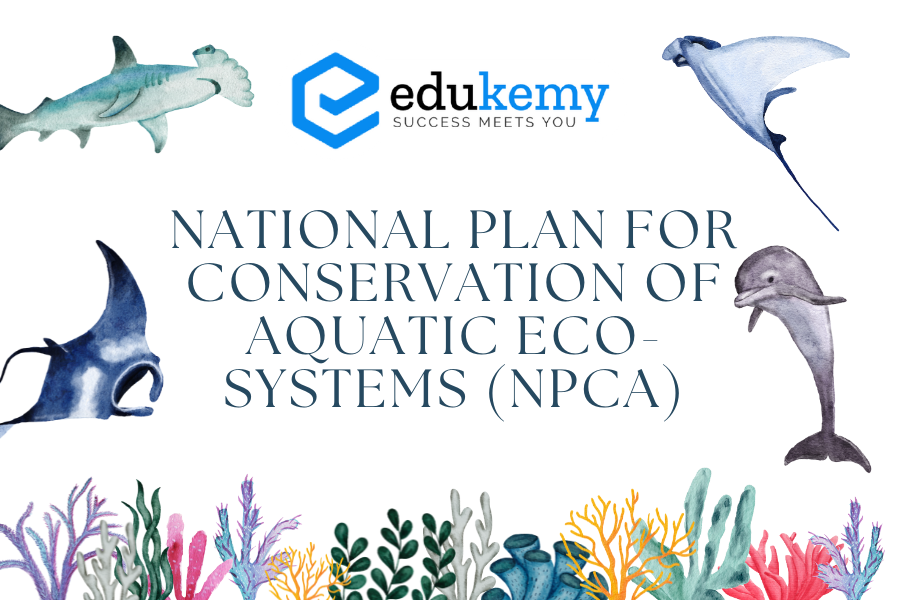- The National Plan for Conservation of Aquatic Ecosystems (NPCA) is a conservation initiative focused on wetlands and lakes.
- It emerged by amalgamating the National Lake Conservation Plan and the National Wetlands Conservation Programme.
- This centrally-sponsored scheme is currently administered by the Ministry of Environment, Forest, and Climate Change (MoEFCC).
- The allocation of central aid is contingent on submissions from state governments, considering specified criteria and the availability of funds.
The program encompasses a range of activities, including the interception, diversion, and treatment of wastewater, shoreline protection, lakefront development, in-situ cleaning (desilting and de-weeding), stormwater management, bioremediation, catchment area treatment, lake beautification, survey and demarcation, bio-fencing, fisheries development, weed control, biodiversity conservation, education and awareness creation, and community participation, among others.
Contents
Aim & Objectives of NPCA (National Plan for Conservation of Aquatic Ecosystems)
Aim:
- The NPCA strives for the comprehensive conservation and restoration of lakes and wetlands.
- The primary goal is to achieve significant improvements in water quality, enhance biodiversity, and restore ecosystems.
- The approach is integrated and multidisciplinary, operating under a common regulatory framework.
Objectives:
- Holistic Conservation: Implementing measures that address the entire spectrum of issues related to the health and sustainability of lakes and wetlands.
- Water Quality Enhancement: Focusing on actions that lead to a measurable and sustainable improvement in the quality of water in targeted aquatic ecosystems.
- Biodiversity Improvement: Undertaking initiatives to enhance the variety and abundance of species within lakes and wetlands, contributing to a healthier ecosystem.
- Integrated Approach: Employing a multidisciplinary strategy that combines various conservation methods to address ecological, hydrological, and environmental aspects.
- Common Regulatory Framework: Establishing and adhering to a unified set of regulations and guidelines to streamline conservation efforts and ensure effective implementation.
- Pollution Load Reduction: Contributing to the reduction of pollution loads in lakes and wetlands, thereby minimizing adverse impacts on the environment and aquatic life.
- Stakeholder Benefits: Improving the goods and services provided by lakes and wetlands to stakeholders, acknowledging the vital role these water bodies play in supporting various ecological functions.
- Community Involvement: Encouraging active participation and collaboration with local communities to create a sense of ownership and responsibility towards the conservation of aquatic ecosystems.
The NPCA’s comprehensive approach, guided by these objectives, aims to create a sustainable and thriving environment for lakes and wetlands, benefiting both the ecosystem and the communities dependent on these vital water bodies.
FAQs: National Plan for Conservation of Aquatic Ecosystems
1. What is NPCA, and what does it focus on?
A: The National Plan for Conservation of Aquatic Ecosystems (NPCA) is a dedicated conservation initiative aimed at wetlands and lakes in India. It addresses the holistic well-being of these aquatic environments.
2. How did NPCA originate?
A: NPCA emerged by combining two pre-existing plans: the National Lake Conservation Plan and the National Wetlands Conservation Programme. This amalgamation resulted in a more comprehensive and integrated approach.
3. Who oversees the implementation of NPCA?
A: The Ministry of Environment, Forest, and Climate Change (MoEFCC) currently administers the NPCA scheme at the national level.
4. How is funding allocated under NPCA?
A: Central aid is provided based on proposals received from state governments. The allocation considers specific criteria and the availability of funds.
5. What activities are covered under NPCA?
A: NPCA encompasses a wide range of activities, including wastewater interception, diversion, and treatment, shoreline protection, lakefront development, in-situ cleaning (desilting and de-weeding), stormwater management, bioremediation, catchment area treatment, lake beautification, survey and demarcation, bio-fencing, fisheries development, weed control, biodiversity conservation, education and awareness creation, and community participation.
In case you still have your doubts, contact us on 9811333901.
For UPSC Prelims Resources, Click here
For Daily Updates and Study Material:
Join our Telegram Channel – Edukemy for IAS
- 1. Learn through Videos – here
- 2. Be Exam Ready by Practicing Daily MCQs – here
- 3. Daily Newsletter – Get all your Current Affairs Covered – here
- 4. Mains Answer Writing Practice – here

